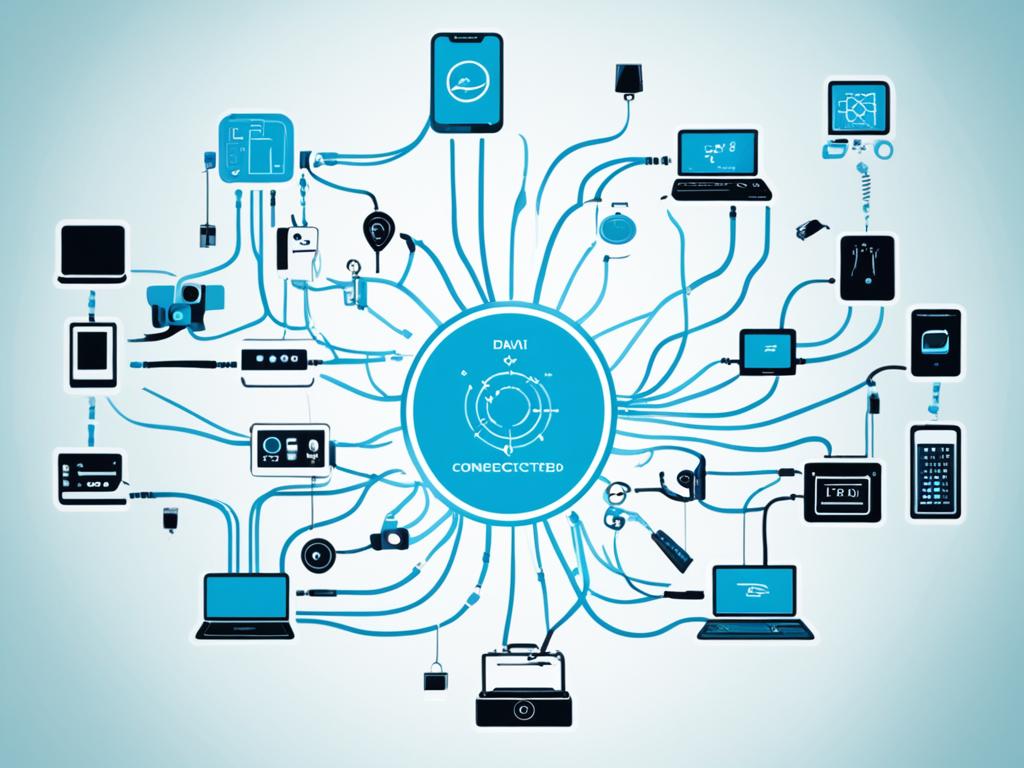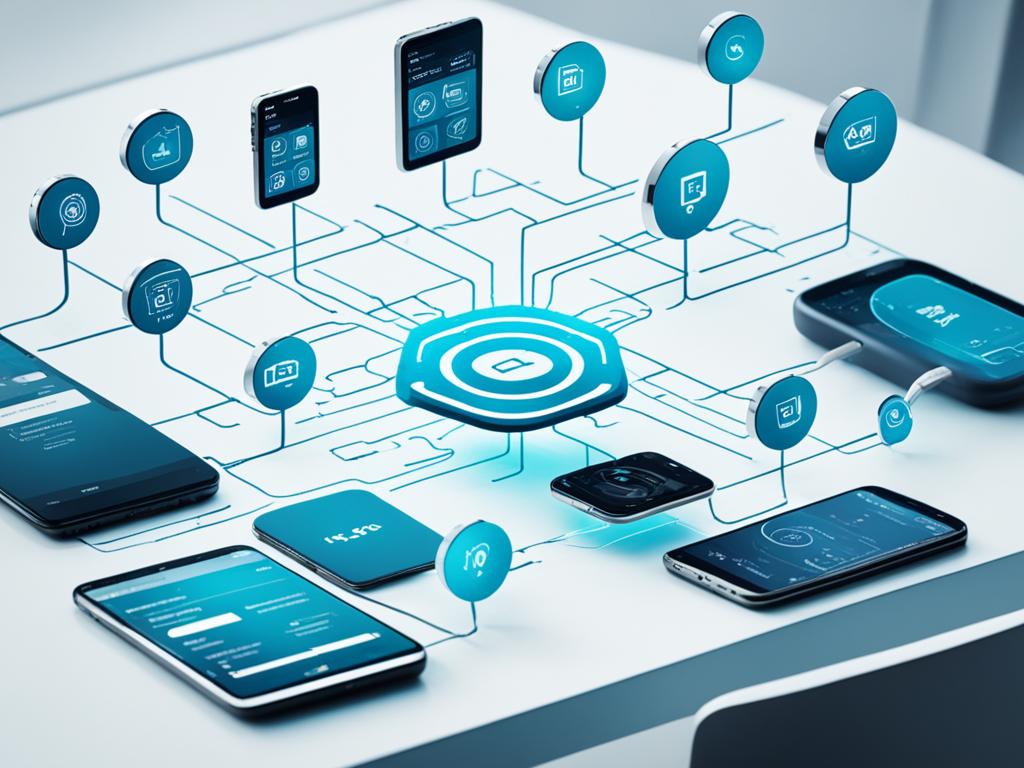Wonder how our devices are all linked, making life smarter and easier? It’s thanks to the Internet of Things (IoT). This new way of connecting things has changed how we use technology. It opens a door to many new ideas by tying different devices together.
IoT includes everything from our phones to the very homes we live in. It lets us do things like control the stuff in our houses, watch our health, and even run factories better. So, how does linking everything through IoT actually happen? And why is it good for us to use IoT every day? Join us, and let’s dive into the amazing world of IoT to see how it’s shaping our future.
Key Takeaways:
- The Internet of Things (IoT) connects everyday devices, making our lives smarter and more efficient.
- IoT devices are seamlessly interconnected through IoT technology.
- Incorporating IoT into daily life offers numerous benefits, from convenience to efficiency.
- IoT connectivity enables us to control our appliances, monitor our health, and streamline various processes.
- By understanding and integrating IoT into our routines, we can unlock the full potential of connected devices.
Understanding IoT Technology

The world is getting more connected, all thanks to IoT technology. IoT stands for the Internet of Things. It’s a network of devices that talk to each other. This makes our lives easier and smarter.
IoT lets devices connect and share information. They work together without much help from us. This is changing how we use technology in our daily lives and at work.
Connected devices are the heart of IoT. They can be anything from your smart fridge to sensors in factories. These devices collect and share data. This helps them make smart choices on their own.
But IoT isn’t just about the devices. It’s how they fit into our lives that matters. When combined smoothly, these devices can make our lives more productive and comfortable.
Benefits of IoT Integration
Integrating IoT into our lives has many advantages. It makes things more convenient, efficient, and automatic.
- Improved Efficiency: Devices work together better, cutting down on wasted energy and resources.
- Enhanced Convenience: You can control your devices from far away. This makes managing your spaces easier.
- Smart Automation: Devices can do regular tasks on their own. That means less work for you.
- Data-driven Insights: Devices gather and analyze data. This information helps us make better decisions and improves our lives.
IoT is making our environments smarter and our lives more connected. It’s changing how we live daily.
IoT technology lets devices talk to each other, making a network that changes our lives. By using IoT, we can fully enjoy what connected devices offer. This boosts efficiency, convenience, and automation.
Now, let’s look closer at how IoT devices are changing our everyday lives. We’ll see how they make our daily experiences better.
Benefits of IoT in Daily Life
The use of IoT gadgets in our daily routines adds many advantages. It makes our lives easier, more efficient, and increases the functionality of everyday tasks. This is done through smart devices and new IoT solutions.
Convenience at Your Fingertips
IoT gadgets bring unbeatable convenience by taking over tasks and making daily actions simpler. For instance, smart home setups let you adjust lights, room temperature, and security from your phone. Voice-activated helpers can also do various tasks. They make life not just easier, but more efficient.
With IoT, you can tweak settings, keep an eye on your home, and even shop for food with just a few clicks or words. This unifies IoT gadgets into our routines, making things smoother and saving us time.
Enhanced Efficiency and Productivity
IoT makes things work better by linking devices and letting them make smart choices. Look at smart cities; IoT eases traffic jams by using data from sensors to change traffic lights as needed. This means better flow for everyone. In factories, IoT watches over machines and tells when they need work, avoiding sudden breakdowns, which keeps work going.
Improved Quality of Life
IoT gadgets can really boost our lives by offering personal touches and better health checks. Items like smartwatches keep an eye on health, so people can meet goals and stay healthy by making smart choices. Health IoT can also check in on people from afar, lessening hospital trips.
Additionally, for home life, IoT can make the atmosphere just right by adjusting lights, room temperature, and more just how we like it.
IoT devices offer unparalleled convenience, enhanced efficiency, and improved quality of life.
Adding IoT into our days can make our life more organized and connected. The ease and helpfulness of smart gadgets, along with advanced IoT solutions, present many ways to better our daily schedules and feel great overall.
IoT Connectivity and Security
Having strong IoT connectivity is key for devices to work well together. As IoT tech grows quickly, the importance of safe and dependable connections is clear.
IoT connectivity lets devices talk to each other and the web. This allows for real-time data sharing and helps in running tasks automatically. Things like smart homes, health gadgets, or industrial sensors need steady connections to work smoothly.
Yet, as more devices join in, security worries increase. Because IoT devices link, they can face cyber threats. Hence, putting strong security in place is a must. This guards private info and user privacy.
“Security is not a product, but a process. It’s about constantly assessing risks, identifying vulnerabilities, and implementing proactive measures.”
– Rob Hale, Chief Executive Officer at Granite Telecommunications
Steps are being taken to make IoT safer. These include using end-to-end encryption, multiple ways to confirm identity, and secure ways to talk. Also, keeping devices up-to-date with security patches helps fight new threats.
IoT security best practices:
- Implement strong passwords and change them regularly.
- Encrypt data to protect it from unauthorized access.
- Use firewalls and intrusion detection systems to monitor network traffic.
- Regularly update and patch IoT devices with the latest security fixes.
- Implement secure communication protocols such as Transport Layer Security (TLS).
- Enable two-factor authentication for added security.
By focusing on good IoT connectivity and strong security practices, both organizations and people can make the most of their devices. This keeps their data safe and private.
The Importance of IoT Connectivity
Setting up reliable IoT connectivity is vital for making connected devices work in different fields. Let’s look at why IoT connectivity is so crucial:
- Real-time data exchange: IoT lets devices share info instantly, which is great for quick decisions and automation.
- Efficient resource management: Devices can send data on things like energy use and inventory, helping organizations manage resources better.
- Remote monitoring and control: With IoT, users can watch and control gadgets from afar, making it easier to oversee operations.
- Enhanced customer experience: Data from devices lets companies offer personalized services, boosting customer happiness.
- Improved productivity and efficiency: IoT automates and simplifies tasks, which ups productivity and efficiency.
In short, IoT connectivity is the base for a connected future. Strong, safe connections unlock the full power of connected devices, spurring innovation in many sectors.
Industries Revolutionized by IoT
IoT tech has changed many industries, making them more effective, productive, and user-friendly. Let’s check out how IoT has made big impacts in several sectors.
1. Healthcare
Healthcare has made big strides thanks to IoT. Wearable health trackers and remote systems gather real-time data. This means better, more personalized care for patients. Smart healthcare devices can even make remote doctor visits better, which may lower in-person trips.
2. Transportation
The transport industry has become safer, greener, and more efficient with IoT. It tracks vehicles in real time, improving travel planning and reducing fuel use. Connected vehicles can even tell you when they need maintenance, making fleet management smoother.
3. Manufacturing
IoT has turned manufacturing towards smart factories. These use sensors to watch over machine performance and products in real time. Predictive maintenance helps stop machine problems before they start, lowering downtime and scheduling production better.
4. Retail
Retail has changed a lot with IoT. Stores use smart shelves and inventory tech for better stock control. IoT also makes paying and shopping easier for customers, with systems that know what you like or need.
5. Energy
In energy, IoT has led to smart grids. These grids more wisely use power and cut down on waste. Energy monitoring lets people see their use live, helping them save money and energy.
IoT is making big changes in many areas, including these. As tech gets better, we’ll likely see more big jumps in all sorts of industries.
Integrating IoT into Daily Life
Adding IoT technology and smart devices to our daily routines offers many benefits. It brings convenience, efficiency, and better experiences to us. By mixing IoT devices into what we already do, we step into a more connected and automated world.
It’s important to pick smart devices that fit well with others in the IoT world. Choosing those that sync well with what you already use makes the process smoother.
After choosing the right devices, setting them up is the next step. You do this by getting them to talk to each other and setting up features. Many IoT devices make this easy with simple apps and interfaces. This way, you can personalize your experience and tailor settings to your needs.
IoT isn’t just about single devices. It’s about linking them all up so they work well together. Creating a network where devices share info boosts what they can do together.
Think about a smart home. It lets people control aspects like lighting, temperature, and security easily. You can set up your home to respond to your needs without even thinking about it.
Beyond homes, IoT tech is making big changes in health, transport, and making things. It helps businesses run smoother, be more productive, and use resources better.
“IoT integration is revolutionizing industries, unlocking new possibilities for efficiency and innovation,” says a study in the Journal of Internet Technology and Applications.
By bringing IoT and smart devices into our lives, we make everything easier, more convenient, and connected. This move towards full integration from homes to whole cities is leading us to a future where everything works together for the better.
Future Trends in IoT
The Internet of Things (IoT) is changing our lives more than we can imagine. And it’s not slowing down. Many new trends are about to change how we live and use our smart devices.
Edge computing is getting a lot of attention in IoT. With this, data is processed closer to where it’s needed. This decreases delays and allows for quick decisions. IoT gadgets will be able to handle information faster and react to our commands in no time.
Forbes sees edge computing becoming a big deal in IoT. It will propel areas like driverless cars, smart cities, and automated industries forward.
AI is a big part of IoT’s future too. By using AI and learning from experience, IoT devices will get smarter. They’ll make decisions by themselves, using up-to-the-minute data. This means processes will be more efficient, machines will break down less, and users will have better experiences.
Forbes believes AI-powered IoT will transform healthcare, farming, and energy use. It will increase productivity and help the planet too.
Let’s not forget about 5G. It’s going to change the game for IoT. Its fast speed and low delay will make IoT connections better. This will make cool things like smart cars, homes, and AR really take off.
Future Trends in IoT
- Edge computing is at the heart of IoT’s efficiency and quick decision making.
- AI makes IoT devices smarter and more independent.
- 5G enables quick and dependable connections for all sorts of IoT applications.
| Trend | Impact |
|---|---|
| Edge computing | Cuts down on delay, makes quick decisions, and boosts how well IoT gadgets and systems run. |
| AI integration | Gives IoT devices the brains to make smart choices, predict when they need a check, and delight users. |
| 5G technology | Brings about faster and dependable links, unleashing IoT’s full power across various fields. |
IoT’s future is bright thanks to these trends. They’ll bring us closer, run smoother, and think smarter.
Conclusion
The Internet of Things (IoT) is key in linking our devices for smarter living. It opens up a new world of possibilities by changing how we interact with our environment.
IoT connects devices like gadgets, wearables, and smart home systems. This connection boosts convenience, productivity, and sustainability. For example, homes can adjust to our needs and cars can move more smoothly through traffic.
IoT keeps getting better, offering endless ways to improve our lives. With it, we can securely control many devices, making smart choices and customizing our surroundings. Everywhere from healthcare to making products, IoT is changing the game, making things more efficient and sparking new ideas.
The future of IoT shines bright, with constant new ideas and growth. The world is becoming more connected, meaning our devices will work together effortlessly, making life easier. Thanks to the Internet of Things, a more linked and smarter future is on its way. Here, devices will collaborate to make our days better.




